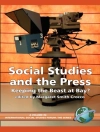Although written simply enough to be accessible to undergraduates, accomplished scholars are likely to appreciate it too. Reading it taught me quite a lot about a subject I thought I knew rather well.
– Paul Vogt, Illinois State University
‘This book brings the art and science of building and applying innovative online research tools to students and faculty across the social sciences.’
– William H. Dutton, University of Oxford
A comprehensive guide to the theory and practice of web Social Science. This book demonstrates how the web is being used to collect social research data, such as online surveys and interviews, as well as digital trace data from social media environments, such as Facebook and Twitter. It also illuminates how the advent of the web has led to traditional social science concepts and approaches being combined with those from other scientific disciplines, leading to new insights into social, political and economic behaviour.
Situating social sciences in the digital age, this book aids:
- understanding of the fundamental changes to society, politics and the economy that have resulted from the advent of the web
- choice of appropriate data, tools and research methods for conducting research using web data
- learning how web data are providing new insights into long-standing social science research questions
- appreciation of how social science can facilitate an understanding of life in the digital age
It is ideal for students and researchers across the social sciences, as well as those from information science, computer science and engineering who want to learn about how social scientists are thinking about and researching the web.
Tabela de Conteúdo
Chapter 1. Introduction
PART ONE: WEB SOCIAL SCIENCE METHODS
Chapter 2. Online Research Methods
Dimensions and Modes of Online Research
Online Surveys
Online Interviews and Focus Groups
Web Content Analysis
Social Media Network Analysis
Online Experiments
Online Field Research
Digital Trace Data: Ethics
Chapter 3. Social Media Networks
Social Networks: Concepts and Definitions
Social Network Analysis
Social Media Networks
Social Networks, Information Networks and Communication Networks
SNA Metrics for the Example School Friendship Network (advanced)
Chapter 4. Hyperlink Networks
Hyperlink Networks: Background
Three Disciplinary Perspectives on Hyperlink Networks
Tools for Hyperlink Network Research
PART TWO: WEB SOCIAL SCIENCE EXAMPLES
Chapter 5. Friendship Formation and Social Influence
Homophily in Friendship Formation
Social Influence
Chapter 6. Organisational Collective Behaviour
Collective Behaviour on the Web: Background
Collective Action and Public Goods
Networked Social Movements
Chapter 7. Politics and Participation
Visibility of Political Information
Social and Political Engagement
Political Homophily
An Introduction to Power Laws (advanced)
Chapter 8. Government and Public Policy
Delivery of Information to Citizens
Government Authority
Public Policy Modelling
Chapter 9. Production and Collaboration
Peer Production and Information Public Goods
Scholarly Activity and Communication
Network Structure and Achievement
Chapter 10. Commerce and Marketing
Distribution of Product Sales
Influence in Markets
Sobre o autor
Assoc. Prof. Robert Ackland has a joint appointment in the School of Sociology and the Australian Centre for Applied Social Research Methods (Aus Cen) at the Australian National University (ANU). He was awarded his Ph D in economics from the ANU in 2001, and he has been researching online social and organisational networks since 2002. He leads the Virtual Observatory for the Study of Online Networks Lab (http://voson.anu.edu.au) which was established in 2005 and is advancing the social science of the Internet by conducting research, developing research tools, and providing research training. Robert established the Social Science of the Internet specialisation in the ANU′s Master of Social Research in 2008, and his book Web Social Science: Concepts, Data and Tools for Social Scientists in the Digital Age (SAGE) was published in July 2013. He created the VOSON software for hyperlink network construction and analysis, which has been publicly available since 2006 and is used by researchers worldwide.












